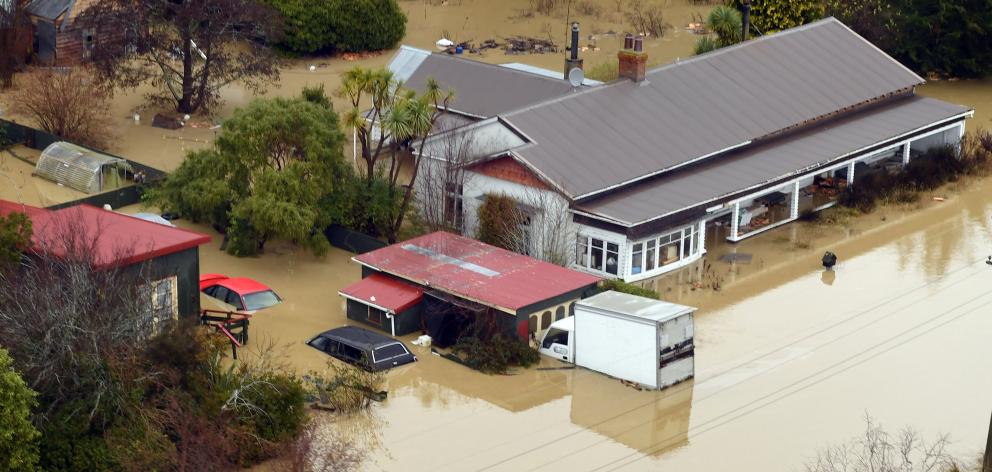
Where were you on Friday the 21st and Saturday the 22nd of July? Were you tucked up high and dry, waiting out the weather? Were you out clearing drains or sandbagging in the neighbourhood? Did you lift what valuables you could up high to keep them out of the flood? Were you getting cold and wet and despondent and not knowing what to do or where to go?
The July 2017 flooding had a heavy impact in our area and it’s during these events that poor quality housing becomes an even greater threat to health than usual. During the recent floods, some residents who were already at risk were tipped into crisis. How we respond to these problems, both in the immediate moment of need and over the longer term, defines the society we live in.
Greater South Dunedin escaped the worst of the flooding in July, but homes on the Taieri and north of the city in the Blueskin area were hit, along with infrastructure. Of course, wilder weather doesn’t just mean flooding. The ODT also documented extensive slips around the city, damaging homes, roads and infrastructure such as fibre networks.
As part of the Climate Safe House project, I’ve been looking at work others have done on planning for climate change. In an excellent Building Research Association NZ report from 2007 the authors discuss the findings of an "Assessment of the Need to Adapt Buildings in New Zealand to the Impacts of Climate Change".
The first point they make is that for "most householders, fear of intruders (burglars, home invasion, peeping toms) is much greater, more immediate, and has more social and housing impacts (including choice of neighbourhood and demand for security features) than fear of climate change".
They go on to talk about social tensions as immigration to New Zealand grows and fuels the need for housing; something that has clearly been one of the contributors to rising house prices for some years now.
Housing is an investment but it is also where people live and it is vulnerable to outside factors such as as "global economic factors, the cost of capital, tax on capital gains, insurance sector policy in relation to housing, and local authority regulation". As a consequence, it will be difficult to ensure a coherent approach to adaptation, they argue, and this is certainly proving to be the case.
One important aspect discussed in the paper is the disruption to social hierarchies that is anticipated. It is envisaged that we will experience "significant social disruption and conflict over changing patterns in the value of land in coastal areas, especially where wealthy enclaves suffer significant loss in value".
My great grandparents had a holiday home in Waitati. There are few holiday homes left in Waitati now, and most homes are now permanent dwellings, although they were not originally built to be lived in year round. Many coastal settlements outside of the main urban areas have become permanent residential areas, no longer simply collections of idiosyncratic wee cribs at the water’s edge only inhabited in summer, and over time infrastructure such as roads, electricity and sewerage has further developed to service them.
What can we do when housing and communities are in exposed locations?
Five of the report’s recommendations are:
1. Implement a climate change adaptation plan for New Zealand. Because we face known risk and because housing and associated infrastructure is planned assuming stability, our planning needs to take that risk into account.
2. Develop and retrofit with consideration of increasing climate exposure and vulnerability. Hint: the authors make a strong point about ensuring existing housing receives insulation as well.
3. Build the sector’s proactivity. In other words, look for synergies so that we deliver better health and social outcomes along with climate-safe housing.
4. Orient housing adaptation to social exclusion. This means targeting assistance to the most socially vulnerable first.
5. Reduce sector’s carbon footprint. Incorporate lifecycle embodied energy and lifecycle environmental impact into all design.
In many ways, this report illustrates how much we haven’t done or implemented over the past decade. The authors may have hoped we, as a society, would be able to take rational action based on good science. We still can, but it’s going to need a cultural shift to working collectively and in the interests of basic needs, not wants.
Housing provides shelter from the elements. It helps us keep warm, cosy and healthy. That is the essential benefit. Obviously, we need to seek good national and local policy from our political leaders, but we also need to keep this essential idea front and centre in order to build a collective adaptive response to the impacts of climate change.
The complexity of the challenge just means we have to be creative and adventurous and be unafraid to take all opportunities to reduce the climate risk.
- Scott Willis is the project manager of Blueskin Energy Ltd. Each week in this column, one of a panel of writers addresses issues of sustainability.











